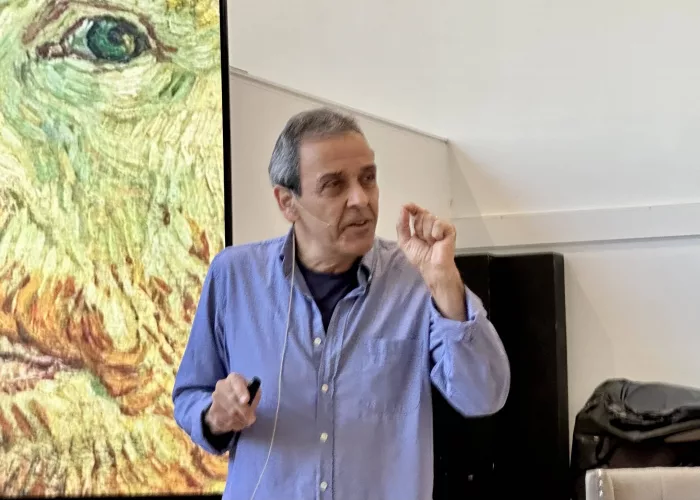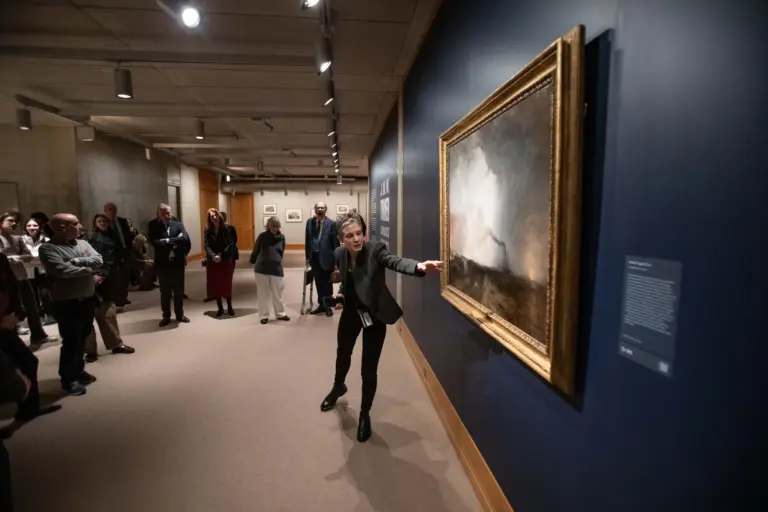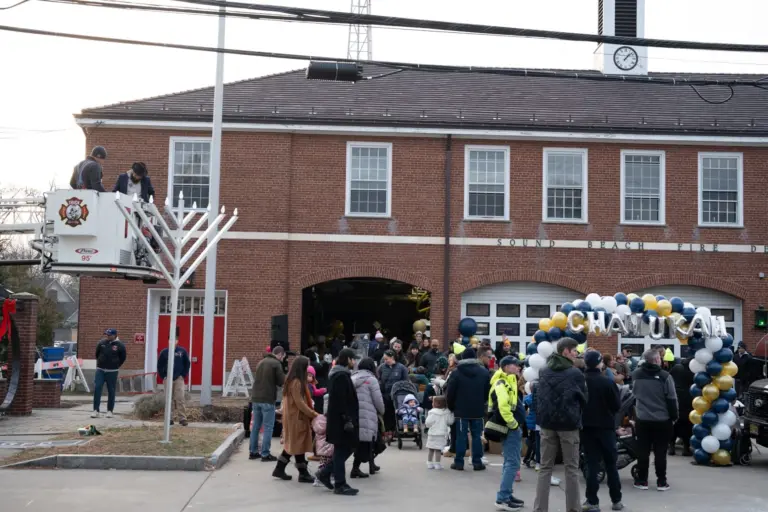
By John Reese
On May 7 at the Retired Men’s Association attendees listened attentively as Turkish-American artist Serdar Arat explored the shadowy world of art forgeries, where masterful deceptions have fooled experts for centuries and continue to plague museums worldwide. “Art fakes and forgeries give us the combined satisfaction of a crime mystery and the profound contemplation of what we expect from art in the first place,” said Arat, an accomplished visual artist and emeritus professor of art at Concordia College-New York, with a career spanning four decades of exhibitions primarily in New York and Istanbul.
The presentation revealed how the art world’s weaknesses – astronomical prices, institutional reputations, and expert egos – create fertile ground for sophisticated deception. Arat demonstrated how forgeries expose major fault lines in the art market while simultaneously offering a unique perspective on authentic art. “When you put a fake next to an authentic Van Gogh, for instance, there’s a new opportunity to appreciate the authentic Van Gogh for what it is,” Arat explained.
Arat outlined three primary methods of authentication: provenance (the history of ownership), expert analysis, and scientific examination. The last of these has become increasingly crucial. He described the 1932 Otto Wacker trial in Germany as a watershed moment – the first major case where scientific evidence, rather than expert opinion, proved decisive in exposing Van Gogh forgeries when a Dutch chemist discovered anachronistic resins in the paint. Today’s authentication landscape is dominated by forensic science. James Martin, described by Arat as “the rock star of the art world’s fake authenticity business,” founded a forensic company later acquired by Sotheby’s to provide in-house authentication. Modern forgers, however, study these detection methods to improve their techniques, creating a perpetual cat-and-mouse game.
The Knoedler Gallery scandal of 2011 illustrated the stakes involved. The prestigious six-story New York gallery, which had supplied major museums including the Metropolitan Museum of Art for decades, collapsed after selling approximately 40 forged paintings worth $80 million. The forgeries, purportedly by Jackson Pollock, Willem de Kooning, and Mark Rothko, were actually created by a Chinese artist in Queens who received roughly $100,000 per painting.
One of the most famous historical cases involved Han van Meegeren, who during World War II sold a forged Vermeer to Nazi leader Hermann Göring. When later charged with treason for selling Dutch cultural treasures to the Nazis, van Meegeren claimed his paintings were forgeries – a defense that required him to prove his guilt as a forger to escape execution for collaboration. He demonstrated his techniques in court, became a national hero for duping the Nazis, but died before completing his prison sentence. Elmyr de Hory represents another celebrated case. This Hungarian-born forger created works in the styles of Picasso, Matisse, and Modigliani, among others, inserting over a thousand forgeries into the art market during his 30-year career. His story was immortalized in Clifford Irving’s biography “Fake!” and Orson Welles’ documentary “F for Fake.”
At The Metropolitan Museum of Art, a scandal involving forged Greek terracotta pieces took approximately 35 years to resolve. The museum acquired what they believed were extraordinary ancient works but eventually had to admit were modern forgeries. The forged pieces were so convincing they had been used as standards to judge other artifacts, essentially creating an entirely fictional ancient civilization.
The extent of forgery in the art world is staggering. “Half the stuff that’s out there in museums, private collections, auction houses, whatever, is bogus,” Arat quoted from Thomas Hoving, former director of the Metropolitan Museum of Art. This assessment is repeated by many in the art world, with estimates ranging from 40% to 70% of artwork being inauthentic. Beyond outright forgeries, museums must contend with complex attribution issues. When examining a painting at the National Gallery in London, initially thought to be a fake, experts discovered that about half the painting was original, while the rest was modern forgery. Some forgers were ironically art historians themselves, creating forgeries to prove their own theories about artists’ techniques.
As Arat concluded his presentation, audience members raised questions about artificial intelligence’s impact on forgery detection. He acknowledged that AI is already helping identify suspicious works, citing a Rubens painting at London’s National Gallery that AI flagged with 85% probability of being inauthentic.
The presentation offered a fascinating glimpse into this world where deception and authenticity dance in perpetual tension, leaving viewers to ponder a troubling question: How many masterpieces hanging in the world’s greatest museums might actually be elaborate fakes, waiting for future technology to expose them?
The talk can be viewed by going to the RMA website at https://greenwichrma.org, and clicking on “Speakers.”
The RMA’s upcoming presentation, “FREE at Last: Lawrence Schulman and the Great Artists and Composers of 20th Century Classic American Popular Music” by Lawrence Schulman, is scheduled for 11 AM on Wednesday, May 21, 2025. RMA presentations are held at Christ Church Greenwich, Parish Hall, 254 E. Putnam Avenue, Greenwich, CT 06830.
The Greenwich Retired Men’s Association in Greenwich is proud to announce that Lawrence Schulman, the award-winning music producer, critic, translator, and author, who appeared last year to discuss his two-volume opus on Judy Garland, will return to Connecticut on May 21 to discuss his new book FREE: Words on Music by A Hi-Def Critic in an MP3 World, in a talk that will include rare video clips of his subjects.
This is his second book for BearManor Media and includes all of his writings between 2000 and 2024. The book displays Schulman’s vast knowledge of the Great American Songbook and beyond, such as his ground-breaking reviews and articles on singer-songwriters Tim Buckley and Peter Allen, about whom Schulman’s article won the 2024 ARSC Journal Article of the Year award. His most recent CD, Judy Garland: A Celebration, was released in 2024, and his book Peter Allen: Somebody’s Angel – The Boy from Oz in the Key of Camp was published in 2025. His follow-up to FREE, titled UNFETTERED, will be published in 2026.
French-American Schulman, a graduate of Stony Brook University, the Sorbonne and CREAR is a music producer, critic and translator who has compiled numerous CDs devoted to Judy Garland in the past three decades. While living in Paris between 1971 and 1997, he taught and translated, and currently translates for the French website OpusHD.net. He also worked for French Public Radio as a producer and host. He lives on Mount Desert Island in Maine.
To stream the presentation by Lawrence Schulman at 11 AM on Wednesday, May 21, click on https://bit.ly/30IBj21. This presentation will also be available on local public access TV channels, Verizon FIOS channel 24 and Optimum (Cablevision) channel 79.
Note: The views expressed in these presentations are those of the speakers. They are not intended to represent the views of the RMA or its members.
RMA speaker presentations are presented as a community service at no cost to in-person or Zoom attendees, regardless of gender. Any member of the public who would like to receive a weekly email announcement of future speakers should send a request to members@greenwichrma.org. The RMA urges all eligible individuals to consider becoming a member of our great organization, and thereby enjoy all the available fellowship, volunteer, and community service opportunities which the RMA offers to its members. For further information, go to https://greenwichrma.org/, or contact info@greenwichrma.org.




